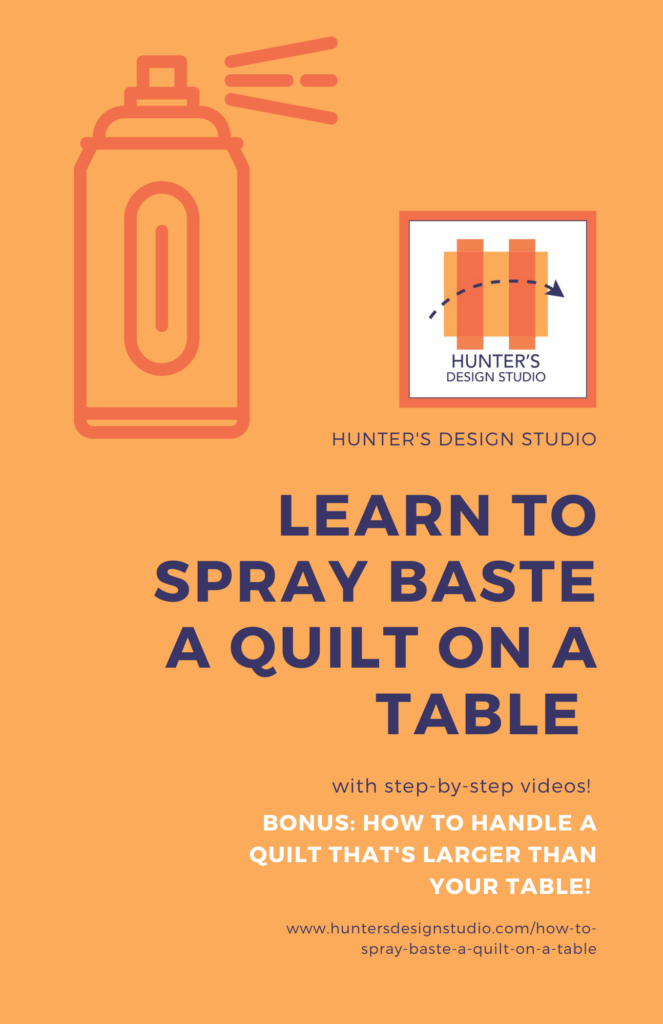In this blog post, I’ll cover some important points to add to my two popular videos on how to spray baste a quilt on a table and how to spray baste a quilt that’s larger than your table.
Quilters use spray basting as a popular and efficient technique to secure their quilt layers before the actual quilting process begins.
Spray basting offers several advantages over traditional methods like pinning, including reduced distortion and improved flatness. Also, because there are no pins in your quilt top, you don’t have to navigate around them for your quilting design.
Use spray basting when you plan to quilt it yourself on a domestic machine – you won’t need to spray baste if you plan to send your quilt to a long-arm artist!
I like to spray baste over a table, rather than the floor, as my knees are much happier! But few quilts are as small as a table so I developed this method for spray basting when a quilt is larger than your table:
Here are some extra tips to go with the videos!
Spray basting is best done outside for ventilation purposes. If you must do it inside, turn off any forced air heating/cooling systems or fans. This will spread the airborne adhesive everywhere. Cover everything important within a 6’ radius with old sheets or drop cloths. Wear a mask!
Make sure your table is clean!
Press your quilt top and backing, and fluff out your batting. This is so it can expand from being tightly packed or rolled.
I like to make sure my backing is at least 8’’ larger than my quilt in both dimensions (essentially 4’’ of extra backing on all 4 sides). It’s hard to center a top perfectly so this allowance makes basting a lot easier.
I like Odif 505 Spray Baste best as I find it the least smelly of the adhesives available. It’s specifically designed for quilting and provides a temporary bond that holds the layers together until quilting is complete. I’ve had basted quilts in the closet for several years and the adhesive held just fine.
I use extra large binder clips to clip onto my table, and I use the thinnest table I can find. It’s also good to have masking or painter’s tape handy.
Even though I start basting at one edge of the quilt, I always work out from the middle of that edge. When smoothing out the quilt, batting, and backing, you want to always be smoothing away from the center and glued parts toward the edges as this introduces fewer wrinkles and puckers.
DO NOT STRETCH the backing, batting, or quilt top. You want it slightly taut, but not tight. If you over-stretch any of the components they will contract and wrinkle once you take it off the table. This leads to puckers and creases in the back while you’re quilting.
Spray the adhesive in sweeps, about 12-18’’ above the surface, as this gets wider coverage.
Check for bubbles and wrinkles before you move the quilt to the next position for basting – especially at the place where the adhesive ends and the not-yet-glued fabric begins. It’s easy to miss a small stripe of glue at that junction!
Smooth down the fabric and batting firmly to activate the adhesive and get the layers to stick. Some people recommend using a warm dry iron at this point to activate the glue. Personally, I don’t do this as I‘ve never had trouble with the glue coming unstuck!
Once you’re happy with the basting, you can trim back excess backing or batting. You can also roll up the raw edges and pin them down to make putting the quilt through your machine easier.
Now, go quilt that quilt!
Shop the post:
(Note, these are affiliate links, if you purchase from these links, I earn a small commission and it costs you nothing!



Thank you for great tips